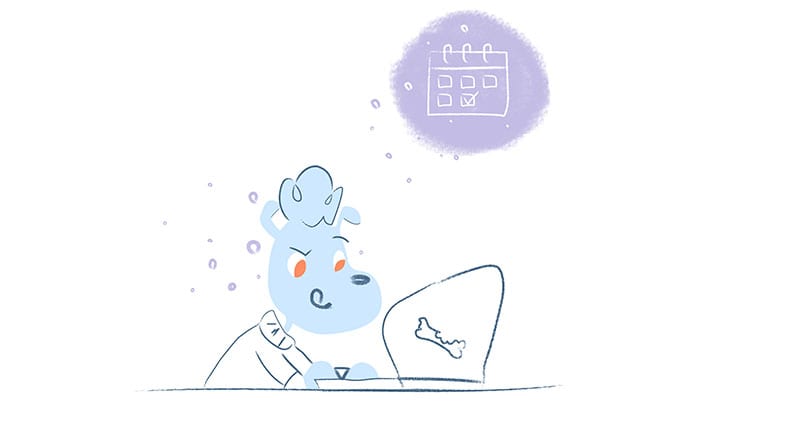

The majority of consumers resonate with digital content. Blogs, email newsletters, paid social media partnerships, and short-form video content are helping drive engagement among businesses and their customers.
The business landscape is changing, and social content is beginning to take off at a stratospheric rate. More businesses rely on digital engagement to foster new customer relationships, increase brand awareness, and drive business growth.
Content is king, and content creators are coming out on top, amassing millions of daily impressions and connecting brands with their target audiences. To some extent, around 52 percent of marketers rely on content creators to strengthen and improve their social community, according to the 2022 Creator Report.
In a fast-moving digital world, where trends pass through rapidly, digital content can give entrepreneurs the edge to establish an identity, drive customer engagement, and seek new outlets to scale their businesses.
However, time-crunched entrepreneurs are missing key opportunities to scale their businesses due to a lack of planning, improper scheduling, and an inability to prioritize content creation. Creating strategies that work for their business needs will help them overcome the issue of not having enough time in their schedule.
This might be the push entrepreneurs need to start scheduling more time to create content for their businesses and push their creativity to the limits. However, to accomplish this, one will first need to understand the importance of having a content Calendar, and how to schedule these tasks more effectively.
How To Create A Content-Focused Calendar
Burnout is one of the most common symptoms for entrepreneurs, who work an average of 60 to 100 hours per week.
Considering this and the fact that content creators spend between 1 and 5 hours per week making new content, with some spending that amount per day, entrepreneurs may find their schedules stretched way too thin to take on additional tasks.
However, the solution shouldn’t be to increase your workload; instead, you should use newer techniques to manage your time and schedule more efficiently. This will allow you to work through all your tasks and prioritize content creation without feeling overwhelmed or burned out.
Set-Up A Content Calendar
Before you can start creating high-quality content, you will need the necessary planning tools to help you achieve this goal. Setting up a content calendar can help drive you in the right direction, allowing you to become more task-focused and limit possible distractions.
Each entrepreneur’s content calendar may look different, allowing them to be flexible while ensuring that the work gets done in time and allowing themselves enough autonomy to make any adjustments or reschedule certain activities.
In your content calendar, you will need to include the following:
- Content format: what type of content are you looking to create, i.e., blogs, photos, videos, etc?
- Content theme: what is the subject of your content?
- Publication date: When are you looking to publish your content?
- Content platform: which platform will you be using for your content?
- Optimization: are you using any tools to help you optimize your content?
- Goals and Objective: what are you looking to achieve with your content?
- Financial considerations: how much money will you spend promoting your content?
Answer these essential questions while setting up your content calendar. You can assign specific days for each task, such as researching trends, following up with collaborators, compiling product images, writing a newsletter, etc.
From this point onward, you can include days of the week when you post or share your content. This is where it’s crucial to start using analytics tools such as Google Analytics, Moz, Sprout Social, Hootsuite, or other leading CRM solutions.
Aligning your content calendar with your work schedule will allow you more time to focus on important tasks, such as running your business. You can also concentrate on new content ideas and set up days and times to create new content to publish online.
Create Dedicated Content Blocks
Using your content calendar, allocate time slots or days of the week to work on your content. By having content blocks, you can be assured that you can prioritize your digital presence and allocate enough time and resources to improve your strategies.
You can use a digital calendar to help you block off time on your schedule. A digital calendar is very easy to use, and the digital features allow you to seamlessly change your schedule to suit your needs.
Having dedicated content blocks will also help you save time, allowing you to focus on other business-related tasks. Content blocks can help you plan your week more effectively and ensure that you can work around existing priorities.
Try to avoid blocking time slots during peak days of the week or hours of the day. For instance, if your business experiences high volumes of traffic during the morning, avoid scheduling a content block during this time. The same goes for days that are typically busier than others or already have a large set of tasks assigned.
By blocking off time, you allow yourself to plan ahead. You also give yourself the chance to avoid having various schedules on the same day, which provides you with much-needed structure for your day-to-day routine.
Prioritize Content Tasks
In the beginning, things can feel overwhelming as there are many different moving parts that you need to consider. Fortunately, this doesn’t have to be the case, and with a digital calendar, you can prioritize content tasks to fit your business needs.
Start by planning your content strategy, which will serve as the blueprint for the rest of your content planning process. Next, consider the content format to indicate how much time you need to allocate to this task.
You might need to prioritize shooting new video content for one week, meaning you will need to block off more of your daily schedule to do this. Next, you might notice that your website content needs to be refreshed, and although this isn’t a priority, you can schedule this for a later time of the month.
Go through each of the tasks you have in mind and consider how important each one is to your business. Sure, you might want to have everything done within a couple of days, but creating high-quality content takes time and resources.
Establish a roadmap for yourself, and evaluate how each moving piece will help you complete the bigger picture. Make time for the important things right now, and allow those that can be done later to be scheduled at the most convenient time.
Leverage Digital Tools
Today, roughly 84 percent of small business owners use digital tools to help them sell products and services. Not only this, but a robust 87 percent of business owners have said that they use digital tools as a way to find new customers and drive revenue.
From day one, you need to understand the important role digital tools can play in your business, and what better way than with your digital calendar? You may already be using a calendar on your smartphone or computer. However, not all of these devices are always synced, which can lead to confusion and a backed-up schedule.
Applying the right tools across your business can help you become more efficient. Not only this, these tools will help you overcome challenges, be a better problem-solver, and allow you to be more productive in specific tasks that require your hands-on attention.
The same can be said for your content. Plenty of digital tools are available to help you make the most of your digital content. Learning how to use these tools is part of the process, and by prioritizing these tools, you can become more confident in your ability to share and engage with your audience effectively.
Maximize Calendar Features
Various tools can help you maximize your time, making you more efficient and productive. As with other types of digital tools, you may find that using a digital calendar can be home to various features, some of which might be entirely new to you at first.
Trying out different features gives you more chances to maximize your daily schedule. These features will allow you to become more flexible and adjust your schedule on the go to fit your preferences automatically.
These features are important when establishing your schedule and prioritizing your content. By applying different features, you can seamlessly share information with different individuals or schedule events on days when everyone on your team is available.
You can track your productivity, allowing you to see which tasks require more attention and whether you are on schedule to finalize the content before it is published. Each small feature on your digital calendar has been designed to make your day-to-day life easier and ensure that you can maximize your time any day of the week.
Prioritize Feedback
Knowing where you might miss out on critical opportunities can be just as important as always being on top of your game. Make time in your schedule for feedback and obtaining recommendations from other experienced content creators and business owners.
This doesn’t have to be a daily occurrence; you can schedule time each month as part of your content calendar. Having a third party to review your content and give you feedback is a valuable asset that you can use to improve your current content strategy and uncover what type of content format works the best for your business.
Another way to obtain feedback for your content is through forums and polls. For instance, you can set up automatic customer feedback forms after an online purchase. Adding incentives to completing these forms is another smart way to drive engagement.
You can apply similar tactics online, such as posting polls on your social media stories and highlights. Having your audience directly interact with you as a business owner will allow you to see where you stand with them and where you might need to improve.
These activities are essential to your business and will deliver valuable insights you can use for your content strategy. However, these things take time, and without properly planning or making yourself available to these sorts of activities, you are losing out on valuable assets that can help drive your business engagement.
Use Evergreen Content
Many content creators use evergreen content to save time. For instance, they may use evergreen content to drive more awareness of a brand or product or to generate more impressions on a specific page.
Examples of evergreen content include:
- Tutorials: Teaching customers and followers about a specific product or service.
- DIY Guides: Showing people how to use a new product more effectively.
- Blog Articles: Explain complex subjects relevant to your business and your customers.
- Checklists: Ensure your customers know all the tips and tricks of using your service.
This type of evergreen content can help entrepreneurs who lack schedule flexibility create new content or develop new ideas. Using evergreen content can also generate an impression of something, such as a new product or service.
It’s important to balance new original content and evergreen content. This will ensure that customers experience your business’ authenticity while learning and engaging more effectively with your brand through alternative channels.
Dedicate Time To Research Trends
Trend cycles move rapidly, and being unaware of new developments can leave your business behind. On average, social media trends can last between two and three days, while more impressionable trends can last anywhere from two to three months.
This doesn’t leave you enough time to jump on the trend bandwagon and create content. Instead, it’s important to consider where your business stands and whether you will likely benefit from any of these online trends.
Using your time and resources wisely, you can leverage trends most applicable to your brand and content strategy. By applying techniques to help you research trends more appropriately, you can create a more authentic brand experience for your customers.
As with anything, block enough time on your schedule to research trends. Keep in mind that research can mean and look different for every person, and you should engage in the activities you feel will add the most value to your business and long-term content planning.
6 Important Questions To Ask When Developing A Content Calendar
Creating a content calendar that resonates with your business needs requires careful planning and consideration. You must consider multiple factors as an entrepreneur, but this can quickly become overwhelming, even for experienced entrepreneurs. However, here are some essential questions that you can use to help guide you throughout the process:
What is the objective of my content?
Similar to laying the groundwork for your business, you need to ask yourself what the objectives of your content will be. Business leaders often create various content formats without considering their business’s long-term needs.
Consider what you want to achieve with your content. Are you looking to build more engagement among your followers, or are you advertising a new product or service? By asking yourself these questions, you will find a clearer direction for your business and content.
Not only this, but having a clear understanding of your content objectives will help you save a lot of time and resources. Knowing what you plan on doing and how you will be doing it will help you schedule certain tasks more appropriately.
How important is my content to my business?
Creating high-quality content can be a game-changing ingredient for your business. However, knowing what to create is as important as understanding how content will add value to your business’s success.
In one particular study, researchers found that around 62 percent of business-to-business (B2B) buyers prefer more practical content, such as case studies, to help them make more informed buying decisions.
Your content can advertise new products, inform customers about a specific service, or assist them with making a more informed decision. Whether your content is to direct more customers to your online store or drive up engagement, make these actions central to your planning.
Do I have all the resources to create content?
A lack of financial resources can hinder the growth of any business. Around twenty-three percent of small business owners have said financial constraints limit their marketing efforts.
Not only should entrepreneurs consider the importance of having sufficient financial support to operate their business effectively, but additional resources such as human capital, machinery, and other digital software can provide significant business benefits.
By taking stock of your business, including your experience and expertise, you will gradually begin to uncover areas for improvement and where an alternative solution may be needed.
How can a digital calendar make me more efficient?
A content calendar can provide small businesses and entrepreneurs the consistency required to generate more leads and effectively engage with their customers. Delivering consistent content will also allow you to establish more credibility among your customers and competitors.
Not only this, but with a proper content calendar, you can better plan for future events, new products, and service launches, which will allow you time to adjust your strategy or any of your content themes.
How much time is needed to develop my content?
Creating high-quality content can take a lot of time, and you must set aside enough time in your schedule to execute your content planning strategies properly.
On average, some content creators spend between one and six hours creating one piece of content. However, this can depend on the type of content you want to create and share and other important factors you consider during your execution phase.
What tools will I need to measure the success of my content?
There are many different tools for measuring the success of your content. We suggest starting with a digital calendar, which will help you plan more effectively and give you better control over all the various moving parts.
Next, consider free and easy-to-use tools. You don’t necessarily want to feel that you must take a masterclass to learn a new program or software.
Additionally, you can leverage available tools through social media platforms and search engines, including Facebook For Business and Google Analytics. You can also use optimization tools to help you create more high-ranking content, including keyword research and click analysis.
Closing Thoughts
Proper planning is essential for staying ahead of the curve and capitalizing on digital content, and for entrepreneurs, this can be a challenge due to a demanding work-life balance.
However, as an entrepreneur, scheduling enough time to prioritize your content planning and content strategy is possible. By applying time management techniques and effectively using a digital calendar alongside other important tools, you can create a schedule that provides enough flexibility to research new trends and produce high-quality content.
Your digital presence can significantly boost your online exposure, allowing you to target the proper audiences while finding new and creative ways to engage with your customers.
Featured Image Credit: Andrea Piacquadio; Pexels











Carma Khatib
Carma Khatib is a passionate innovator and product manager with significant experience driving digital products from conception to launch. My mission is to find and create solutions to real-world problems that ultimately impact a company's triple bottom line: People, Planet, and Profit.